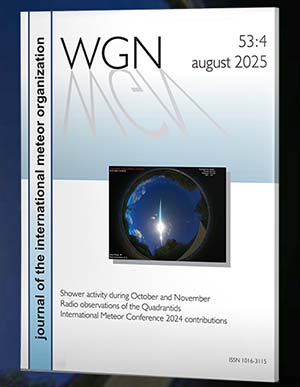No matter where you live, the first half of
December provides some of the best meteor activity of the year. In the northern
hemisphere the sporadic rates are still strong plus you can also count on strong
activity from the Geminids, which peak on December 13. There are also several
minor radiants that add a few meteors each hour. All of these centers of activity
are located high in the sky during the early morning hours this time of year.
Unfortunately this year the bright moon spoils the show during the first week of
the month. During the second week of December the moon will pass its last quarter
phase and will not be such a nuisance .
As seen from the southern hemisphere the sporadic
rates are increasing toward a January maximum. Shower rates are also good but the
Geminids suffer a bit from the lower elevation seen from southern locations. Still
with the warmer weather now occurring south of the equator, December is a great
time to view celestial fireworks.
During this period the moon reaches its full
phase on Wednesday December 2nd. On that date the moon lies opposite the sun and
rises near sunset and sets near sunrise. This weekend the waxing gibbous moon will
set a few hours before dawn, allowing a brief chance at observing under pristine
conditions before morning twilight. The estimated total hourly rates for evening observers
this week is near three as seen from the northern hemisphere and two from the
southern hemisphere. For morning observers the estimated total hourly rates should
be near fifteen from the northern hemisphere and twelve as seen from the southern
hemisphere. The actual rates will also depend on factors such as personal light and
motion perception, local weather conditions, alertness and experience in watching
meteor activity. Rates are reduced during this period due to moonlight.
The radiant positions and rates listed below are exact
for Saturday night/Sunday morning November 28/29. These positions do not change
greatly day to day so the listed coordinates may be used during this entire period.
Most star atlases (available at science stores and planetariums) will provide
maps with grid lines of the celestial coordinates so that you may find out exactly
where these positions are located in the sky. A planisphere or computer planetarium
program is also useful in showing the sky at any time of night on any date of the
year. Activity from each radiant is best seen when it is positioned highest in the
sky, either due north or south along the meridian, depending on your latitude. It
must be remembered that meteor activity is rarely seen at the radiant position.
Rather they shoot outwards from the radiant so it is best to center your field of
view so that the radiant lies at the edge and not the center. Viewing there will
allow you to easily trace the path of each meteor back to the radiant (if it is
a shower member) or in another direction if it is a sporadic. Meteor activity is
not seen from radiants that are located below the horizon. The positions below
are listed in a west to east manner in order of right ascension (celestial longitude).
The positions listed first are located further west therefore are accessible earlier
in the night while those listed further down the list rise later in the night.
The following showers are expected to be active this week:
The Phoenicids (PHO) are a periodic shower that
rarely produces noticeable activity. The only impressive display produced by this
shower occurred in 1956 when ZHR’s were near 100. Peak activity occurs on December
6. Little activity is expected away from the peak night. The radiant is currently
located at 00:48 (012) -52. This position lies in southeastern Phoenix some five
degrees northwest of the bright zero magnitude star Achernar (Alpha Eridani).
These meteors are best seen near 2000 (8pm) local standard time (LST, regardless
of time zone) when the radiant lies highest above the horizon in a dark sky. Due
to the southerly declination of the radiant, this shower is not visible north of
the northern tropical areas. The deep southern hemisphere has the best chance of
seeing any activity. At 18 km/sec. the Phoenicids produce very slow meteors.
Sirko Molau’s studies of video radiants has revealed that activity from the famous
Andromedid (AND) shower, noted for intense storms during the 19th century,
may still be seen throughout November. The current position of the large radiant
is 01:44 (026) +45. This position lies in northeastern Andromeda, five degrees
northwest of second magnitude Almach (Gamma Andromedae). Visual
activity is expected to be low, but detectable. The Andromedid radiant is best
placed near 2100 (9pm) local standard time (LST) when it lies on the meridian
and overhead for observers viewing from mid-northern latitudes . At 19km/sec.,
the average Andromedid will appear as a very slow moving meteor. Sirko mentions
that these meteors are “conspicuously slow and of almost constant activity” during
this period.
The Northern Taurids (NTA) are active from a large radiant centered at 04:52
(073) +25, which lies in eastern Taurus, eight degrees northeast of the orange first
magnitude star Aldebaran (Alpha Tauri). The radiant is best placed near 0000 (midnight)
LST, when it lies highest above the horizon, but activity may be seen all night long.
Meteors from the Northern Taurids strike the atmosphere at 29km/sec., which would
produce meteors of slow velocity. Expected rates would be near two per hour as
seen from the northern hemisphere and one per hour as seen south of the equator.
The November Orionids (NOO) were recently discovered Sirko Molau by analyzing
video data. This shower is active from November 12 through December 6. Maximum
activity occurs on November 30 when rates should be near one per hour, no matter
your observing location. The radiant is currently located at 06:04 (091) +15.
This position lies in northeastern Orion, just west of the fourth magnitude star
Nu Orionis. These meteors are best seen near 0130 LST when the radiant lies on the
meridian and highest above the horizon. At 44 km/sec. the November Orionids produce
mostly medium velocity meteors.
The Sigma Hydrids (HYD) are active from a radiant located at 07:52 (118)
+04. This position lies in eastern Canis Minor, three degrees southeast of the
zero magnitude star Procyon (Alpha Canis Minoris). These meteors are best seen
near 0300 LST when the radiant lies highest above the horizon in a dark sky.
Current rates would be less than one per hour no matter your location. At
61 km/sec. the Sigma Hydrids produce mostly swift meteors.
The Puppid-Velids (PUP) are a vast complex of weak radiants located in the
constellations of Puppis and Vela. Visual plots and photographic studies
have revealed many radiants in this area during November and December. The
combined strength of these radiants can produce a ZHR of ten. Actual hourly
rates will be much less unless you happen to be observing from the deep
Southern Hemisphere. The center of this activity is currently located at
07:52 (118) -45. This position lies in eastern Puppis, four degrees northwest
of the second magnitude star Gamma Velorum. Peak rates occur near December
7. These meteors are best seen near 0300 LST when the radiant lies highest
above the horizon in a dark sky. Observers located in the Southern Hemisphere
have an advantage viewing this shower as the radiant will rise higher into their
sky allowing more activity to be seen. At 40 km/sec. the Puppid-Velids produce
meteors of average velocity.
Some observers have been reporting activity from Ursa Major while viewing the
Geminids. Video studies by Sirko Molau have revealed a radiant active in this
constellation from November 29th through December 13th. Peak rates occur near
December 5th. The radiant of the Psi Ursa Majorids (PSU) is currently
located at 10:36 (159) +45. This position actually lies in Leo Minor, very close
to the position occupied by the third magnitude star Beta Leonis Minoris. These
meteors are best seen during the last hour before dawn when the radiant lies
highest in a dark sky. Current rates would be less than one per hour no matter
your location. Due to the high northern declination these meteors are best seen
from the northern hemisphere. They are completely invisible south of 45 degrees
south latitude. At 61 km/sec. the Psi Ursa Majorids produce mostly swift meteors.
The Leonids (LEO) reached maximum activity on the morning of November 17th
with ZHR’s exceeding 100 as seen over Asia. The last chance to see Leonid activity
in 2009 is this weekend when the radiant lies at 10:44 (161) +14. This position
lies in central Leo, seven degrees southeast of the famous second magnitude double
star Algeiba (Gamma Leonis). Current rates would be less than one per hour no
matter your location. At 70km/sec., the average Leonid is swift with a high
percentage of trains. The radiant is most favorably located during the last dark
hour before the onset of morning twilight when it lies highest in a dark sky.
As seen from the mid-northern hemisphere (45N) one would expect to see approximately
twelve Sporadic meteors per hour during the last hour before dawn as seen
from rural observing sites. Evening rates would be near two per hour. As seen from
the mid-southern hemisphere (45S), morning rates would be near six per hour as seen
from rural observing sites and one per hour during the evening hours. Locations
between these two extremes would see activity between the listed figures. Rates
are reduced during this period due to the intense moonlight.
The table below presents a condensed version of the expected activity this week.
Rates and positions are exact for Saturday night/Sunday morning but may be used
all week long.
| SHOWER | DATE OF MAXIMUM ACTIVITY | CELESTIAL POSITION | ENTRY VELOCITY | CULMINATION | HOURLY RATE | CLASS* | RA (RA in Deg.) DEC | Km/Sec | Local Standard Time | North-South | Phoenicids (PHO) | Dec 06 | 00:48 (012) -52 | 18 | 20:00 | <1 - <1 | III | Andromedids (AND) | Nov 13 | 01:44 (026) +45 | 19 | 21:00 | <1 - <1 | IV | Northern Taurids (NTA) | Nov 13 | 04:52 (073) +25 | 29 | 00:00 | 2 – 1 | II | November Orionids (NOO) | Nov 30 | 06:04 (091) +15 | 44 | 01:30 | 1 – 1 | II | Sigma Hydrids (HYD) | Dec 06 | 07:52 (118) +04 | 61 | 03:00 | <1 - <1 | II | Puppid-Velids (PUP) | Dec 07 | 07:52 (118) -45 | 40 | 03:00 | <1 - 1 | II | Psi Ursa Majorids (PSU) | Dec 05 | 10:36 (159) +45 | 61 | 06:00 | <1 - <1 | IV | Leonids (LEO) | Nov 17 | 10:44 (161) +14 | 70 | 06:00 | <1 - <1 | III |




 You saw something bright and fast? Like a huge shooting star? Report it: it may be a fireball.
You saw something bright and fast? Like a huge shooting star? Report it: it may be a fireball.  You counted meteors last night? Share your results with us!
You counted meteors last night? Share your results with us!  You took a photo of a meteor or fireball? You have a screenshot of your cam? Share it with us!
You took a photo of a meteor or fireball? You have a screenshot of your cam? Share it with us!  You caught a meteor or fireball on video? Share your video with us!
You caught a meteor or fireball on video? Share your video with us!